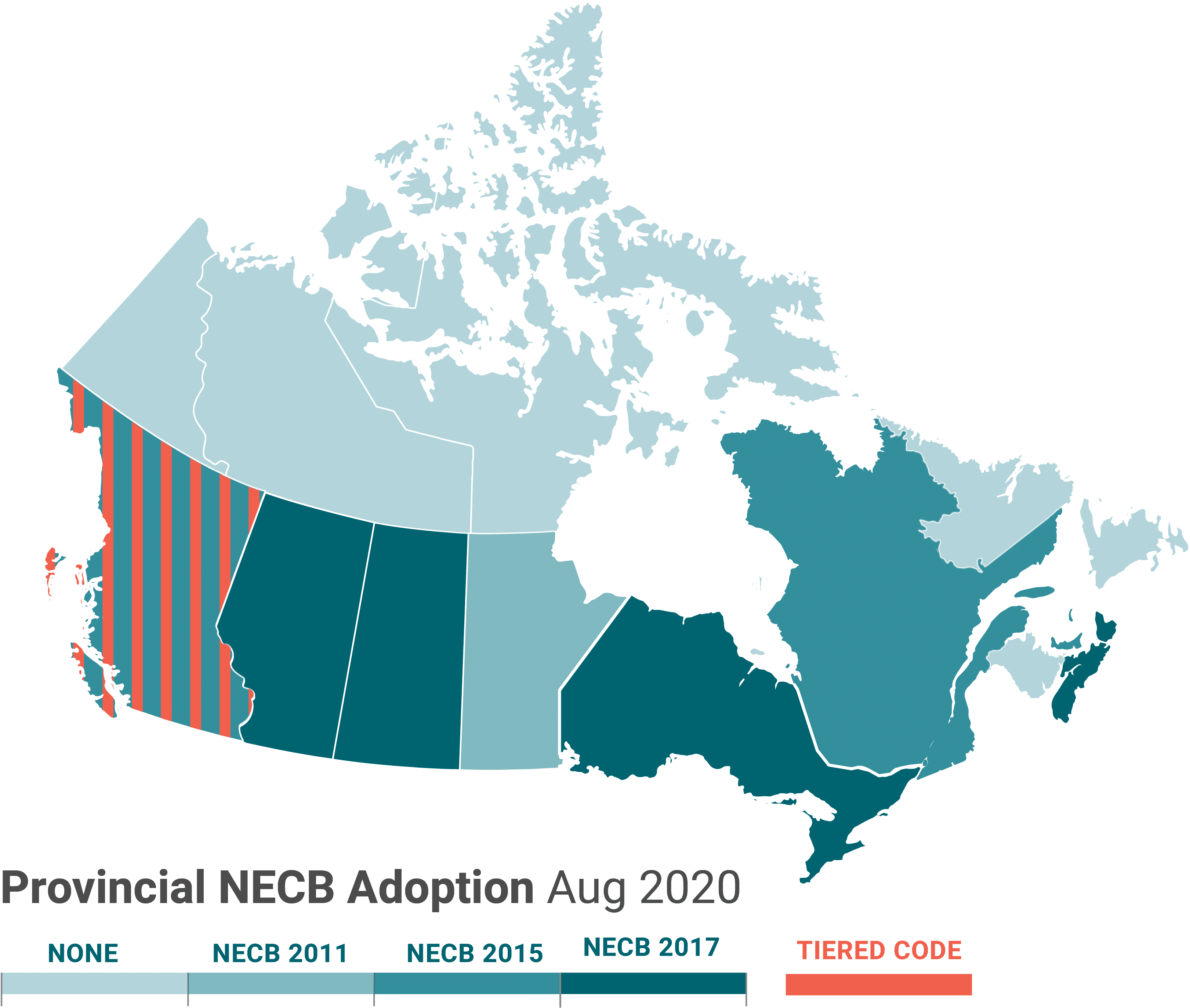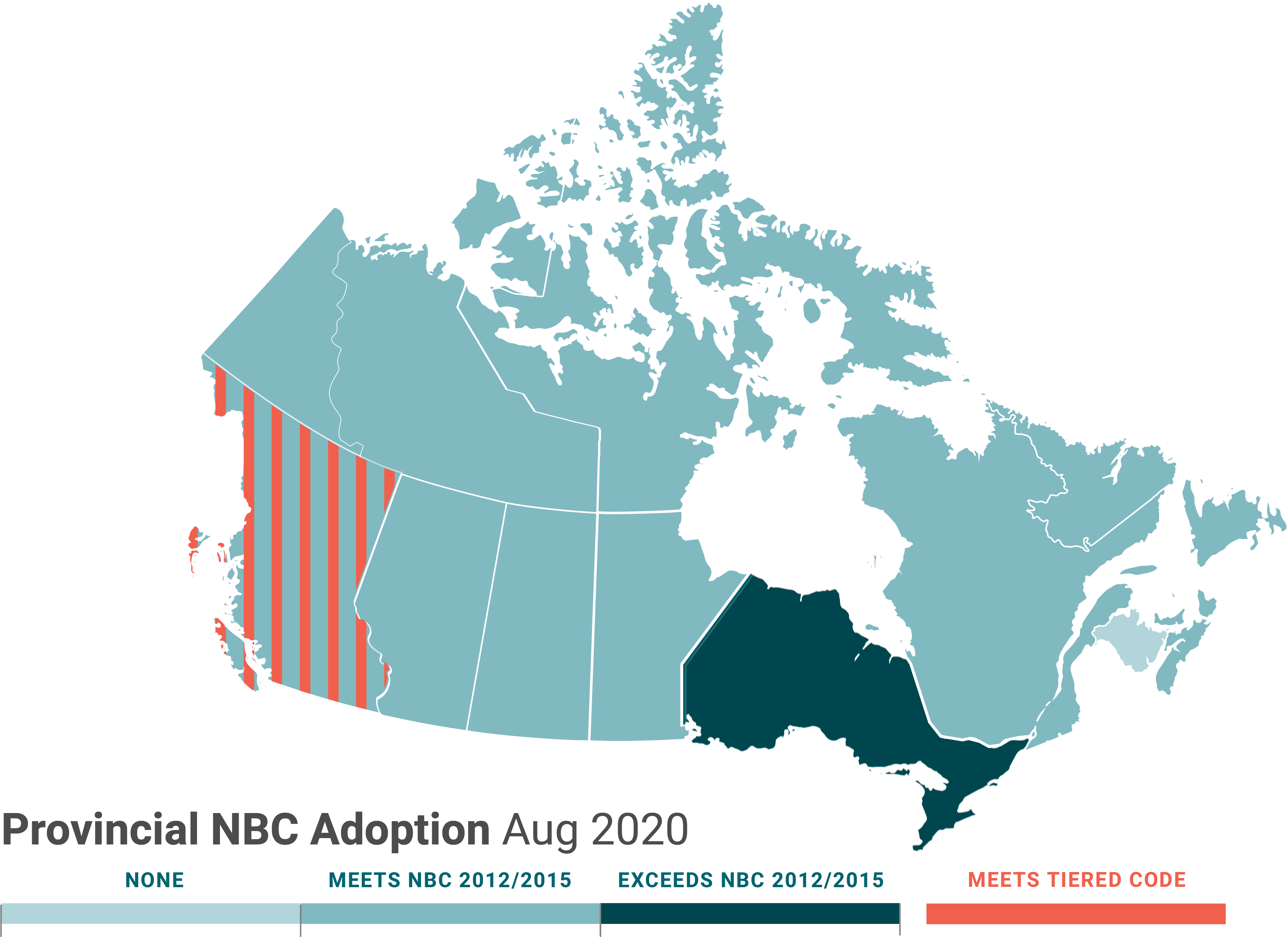Without compliance, do new building codes matter?
To reap the benefits of tomorrow’s tiered energy codes, we need to start planning and actioning compliance initiatives today
Kevin Lockhart
Efficient Buildings Lead
Efficiency Canada

Andrew Pride
Andrew Pride Consulting
November 23, 2020
Blogs | Buildings | Guest Blogs | News
- Tiered energy codes are an important part of Canada’s climate strategy; setting a path to net-zero energy ready (NZER).
- To reap the benefits of tomorrow’s tiered energy codes, we need to start planning and actioning compliance initiatives today.
- We need all stakeholders — federal authorities, provincial and territorial policymakers, builders, and AHJs — to get involved now in order to deliver on Canada’s climate action plans.
Tiered energy codes are an important part of Canada’s climate strategy; setting a path to net-zero energy ready (NZER). Tiered codes will also provide increased energy performance in new buildings, reduce energy waste, and improve affordability. However, there will be limited confidence in these benefits without demonstrated compliance, i.e. verification that buildings are performing as designed.
The best time to plan the “how” in compliance, is before the updated codes are in force across Canada. To reap the benefits of tomorrow’s tiered energy codes, we need to start planning and actioning compliance initiatives today.
A Net Zero Energy Ready (NZER) building is one that is designed, modelled and constructed to minimize the use of energy such that its annual energy consumption can be reasonably offset by renewable energy.
NZER buildings can significantly reduce the climate impact of the building. However, for savings to materialize, buildings need to be constructed to the energy code requirements and energy use compliance demonstrated.
Tiered energy codes are an important part of Canada’s climate strategy; setting a path to net-zero energy ready (NZER). Tiered codes will also provide increased energy performance in new buildings, reduce energy waste, and improve affordability. However, there will be limited confidence in these benefits without demonstrated compliance, i.e. verification that buildings are performing as designed.
The best time to plan the “how” in compliance, is before the updated codes are in force across Canada. To reap the benefits of tomorrow’s tiered energy codes, we need to start planning and actioning compliance initiatives today.
For energy savings to materialize, energy code compliance must be demonstrated.
In our recent report, Tiered Energy Codes: Best Practices for Code Compliance, we found that increasing support for greater compliance amongst all stakeholders in the buildings sector can bridge the gap between policy priorities and energy code compliance. It also builds needed human resource capacity for building officials and energy practitioners alike. An added benefit of early stakeholder engagement is reduced jurisdictional inconsistencies in both the level of compliance and management of compliance reports; which in turn, leads to enhanced stakeholder participation.
First, a bit of background
There are two federally developed model codes that target energy use in new buildings: the National Energy Code of Canada for Buildings (NECB); and Section 9.36. of the National Building Code (NBC) which is used exclusively for low-rise houses and small buildings. Provinces and territories, who have the constitutional authority to regulate building codes in their jurisdictions, are free to voluntarily adopt the model codes as written, with amendments, or they may develop and enforce their own set of codes. There is currently no consistent manner by which provinces and territories adopt codes. Efforts are currently underway to reduce inconsistency. Most recently, under the auspice of the Regulatory Reconciliation and Cooperation Table (RCT), provinces and territories have agreed in principle to harmonize their construction codes, including energy codes.


With one exception, local governments within provinces and territories, referred to as the Authority Having Jurisdiction (AHJ), do not establish their own building or energy codes. The exception is the City of Vancouver which, through their charter city status, developed their own energy step code which was later adopted by the Province of British Columbia. Generally, the AHJ enforces codes within their jurisdictions. Building officials, as agents of the AHJ, are responsible for reviewing building permit applications ensure that all design parameters conform to all relevant building and energy codes. In addition, prior to permitting occupancy, the building officials validate that the constructed building is in accordance with the issued permit.
Tiered energy codes will introduce a new level of complexity to code compliance, particularly for those AHJs who do not currently enforce energy codes. As a result, AHJs and their enforcement arms will need increased levels of support.
Increased support for energy code compliance
As identified in Efficiency Canada’s report, Strengthening Canada’s Building Codes Process to Achieve Net Zero Emissions, the federal government, along with most provincial and territorial policymakers have prioritized energy efficient codes and have committed to NZER for new buildings by 2030. However, there is a disconnect between this objective and the level of preparedness by those responsible for local enforcement of building energy codes. This poses a significant barrier to AHJs as they currently have limited resources to commit to energy code compliance, not to mention the other changes to building codes such as life-safety and new accessibility requirements.
As energy codes become more complex and compliance becomes an increasing concern, AHJs will need to up-skill their existing teams and ensure that those entering the field understand energy modelling techniques. There is also a need to increase consistency in permit submission processes, code interpretations, and compliance reporting. Lack of clarity and consistency is an oft-cited source of frustrations on the part of many stakeholders.
Demonstrating compliance with tiered energy codes will require energy modelling. Though this is an added cost to construction, the added costs can be easily offset through capital cost savings uncovered by early energy modelling. Nonetheless, builders can be reluctant to invest in this early analysis. Instead, they may choose to engage modelling companies after completing the building design, which reduces the potential capital cost savings benefits.
Finally, as reported in Efficiency Canada’s 2019 Provincial Energy Efficiency Scorecard, AHJs are not required to provide compliance statistics. This is not surprising considering that many jurisdictions’ compliance reporting is paper-based, such as printed excel-based checklists. This is a significant missed opportunity; without an electronic database of how buildings are being constructed and to which energy tier, there is little opportunity to improve processes and learn from successes.
Five activities to boost compliance
Our report identified five activities that can be used to engage stakeholders and ensure qualified and trained resources are available to oversee tiered energy code compliance.
| Recommendation | Activities | Outcomes |
|---|---|---|
| 1. Expand National Energy Compliance Guidelines |
|
|
| 2. Create National Compliance Database and Other Digital Compliance Tools |
|
|
| 3. Develop Compliance Funding Models |
|
|
| 4. Increase Stakeholder Training |
|
|
| 5. Enable Provincial/Territorial Subject Matter Experts (SME) |
|
|
While compliance with the lower tiers of the proposed model codes may appear to be straightforward, the path to NZER by 2030 will take a significant amount of work and creativity. We need all stakeholders – federal authorities, provincial and territorial policymakers, builders, and AHJs – to get involved now in order to deliver on Canada’s climate action plans.

